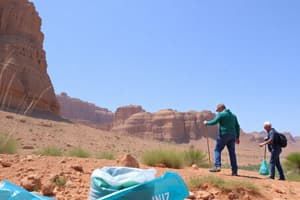Podcast
Questions and Answers
The Jordan River flows into the Mediterranean Sea.
The Jordan River flows into the Mediterranean Sea.
False (B)
Where does the headwater of the Jordan River originate from?
Where does the headwater of the Jordan River originate from?
- Baniyas (Syria) (correct)
- Hasbani (Lebanon) (correct)
- Dan (Israel) (correct)
The intersection point of the three rivers; Dan, Hasbani, and Baniyas, is known as the ______ Valley.
The intersection point of the three rivers; Dan, Hasbani, and Baniyas, is known as the ______ Valley.
Hula
Which river merges with the Lower Jordan River before flowing into the Dead Sea?
Which river merges with the Lower Jordan River before flowing into the Dead Sea?
What factors have been responsible for water conflicts in the Jordan Basin?
What factors have been responsible for water conflicts in the Jordan Basin?
What is the name of the plan aimed at bringing cooperative developments and sharing of water of the Jordan Basin?
What is the name of the plan aimed at bringing cooperative developments and sharing of water of the Jordan Basin?
Israel is the only country that has improved its water security and riparian position from lowermost to upper riparian status.
Israel is the only country that has improved its water security and riparian position from lowermost to upper riparian status.
The Israeli National Water Carrier transports water from Lake Tiberias to _______ in South Western Israel.
The Israeli National Water Carrier transports water from Lake Tiberias to _______ in South Western Israel.
Flashcards are hidden until you start studying
Study Notes
Jordan River Basin
- The Jordan River Basin is a transboundary basin with a total area of 18,500 km², shared by four sovereign states: Israel, Jordan, Lebanon, and Syria, plus Palestine (de jure).
- The basin is divided among the countries as follows: 40% in Jordan, 37% in Israel, 10% in Syria, 9% in the West Bank (Palestine and Gaza Strip), and 4% in Lebanon.
- The Jordan River is 250 km long and flows into the Dead Sea, with its headwaters originating from three rivers: the Dan, the Baniyas, and the Hasbani (the longest of the three), which rises in Lebanon.
Physical Geography
- The Hula Valley, located at the intersection of the three rivers, was once a lake and marshland, but was drained and transformed into agricultural land in the 1950s.
- The Jordan River winds extensively, accounting for its excessive length in comparison to the area it traverses to reach the Dead Sea.
Water Sources
- The main sources of water in the Jordan Basin are:
- Groundwater (aquifers)
- Wadis (both perennial and flood flow)
- Flow of the main rivers (tributaries)
- The three main aquifers in the system are:
- Yarqon Taninin (the most abundant) in the West Bank
- The Northern Aquifer in the northern part of the West Bank
- The Coastal Aquifer in Israel
- The Eastern Aquifer flows into the Jordan River.
Water Scarcity
- The Jordan River Basin is the most water-scarce of all river basins, with a high evaporation rate, especially in the Dead Sea, which is a landlocked salt lake.
- The water level of the Dead Sea drops by about 1m annually, making its water more saline than any ocean.
- Pollution is a major threat to the basin, especially from agricultural activities and pesticide use.
Economic Geography
- The population growth rate in the basin is above the world's average (1.1), with Jordan's population growth rate being 3.5-3.8%.
- Industrialization and urbanization are increasing water demands, with great disparities in GNP among the riparian states.
- Financial aid from donors is a common feature in the basin, with Israel receiving aid from the USA and other Western countries.
National Water Carrier
- Israel constructed the National Water Carrier in 1964, which diverts water from the Sea of Galilee to the Negev for irrigation.
- The carrier consumes a lot of electricity, pumping water from 55-100m elevation.
Hydropolitics
- The Jordan River Basin and its water are central issues in the Arab-Israeli conflict and the Syrian Civil War.
- Each riparian state has adopted a stand or strategy reflecting its riparian station, with some states claiming absolute control over the river.
- The case of Israel is unique in that it has improved its water security and riparian position from a lowermost to an upper riparian status.
Regional Water Projects
- The Johnston Plan (1953) was an initiative to bring about cooperative developments and sharing of water in the Jordan Basin.
- The plan was rejected by the Arab League Council, but the riparian states keep invoking it selectively for their own interests.
- The Israeli National Water Carrier, completed in 1964, transports water from Lake Tiberias to southwestern Israel.
- The Head Water Diversion Plan, proposed by Syria and Jordan, was to divert water from the River Jordan tributaries for development.
Lessons Learnt
- In arid areas, it's not possible to separate issues of water politics from real politics.
- The strongest riparian state in an international basin may improve its water security in the short or medium term.
- International attempts to fashion basin-wide cooperation may not be productive; only when the riparian states themselves begin to negotiate comprehensively can a third party come in.
- Understanding is crucial to lessen conflicts over water sharing.
Studying That Suits You
Use AI to generate personalized quizzes and flashcards to suit your learning preferences.




